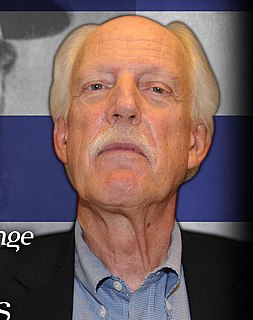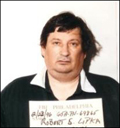Alfred Zehe (born May 23, 1939) is a German physicist, professor and author. After American authorities charged him with spying for the East German government in 1983, he became part of a high-profile prisoner exchange between the U.S. and the Soviet Union.
Born in Farnstädt, Germany, Alfred Zehe was trained from a young age to be an underground copper miner. In 1964, he graduated from the University of Leipzig with a degree in physics; in 1969, he received the degree of Doctor rerum naturalium; and in 1975, he received the degree of Doctor scientiae naturalium. [1] He held a chair in Experimental Physics at the Technical University of Dresden from 1980 to 1991, during which time he taught periodically at the Autonomous University of Puebla in Puebla, Mexico. [2] Prior to the 1990 German reunification, Zehe's ability to travel, including his teaching at University of Puebla, was contingent on his consulting with the East German government on matters of national security. [3]
In 1982, Zehe was summoned from Puebla to the East German embassy in Mexico City to meet with East German officials, who sought Zehe's expertise regarding recently acquired documents on sonar technology. Unbeknownst to Zehe at the time, the documents had been purchased by East German agents from an undercover U.S. operative in Washington, D.C. [4]
The U.S. operative, in an FBI-managed sting operation, had gone shopping on Washington's embassy row "to lure a spy from one or another of the Communist embassies to come out and take the bait." [5] After purchasing the documents, the East Germans realized they lacked the expertise in Washington to evaluate the intelligence, so they called on Zehe in Mexico City. There, he reviewed the documents, which turned out to be outdated information on submarine sonar-detection, and returned to his teaching post in Puebla. [4]
On November 3, 1983, Zehe was arrested while attending the annual symposium of the American Vacuum Society in Boston. [6] He was subsequently charged under the Espionage Act with conspiracy to obtain classified documents related to military technology and deliver them to a foreign government. [6]
The decision to arrest him at the conference with television cameras on hand was designed to fuel public awareness of the dangers of scientific espionage. [7]
The FBI later asked the American Vacuum Society to furnish it with the names of the 2600 attendees at the Boston meeting and threatened to subpoena the information. The Society declined but replied that it would comply with such a subpoena. The FBI did not pursue the matter. [8]
The East German government posted bail for Zehe in June 1984. [6] He remained in Boston while awaiting trial. [7]
Wolfgang Vogel, East German lawyer and spy trader, was enlisted by the East German government to help free Zehe. [9] Vogel contacted Alan Dershowitz to oversee the legal aspects of the effort and Ronald Greenwald to act as personal liaison between him and Zehe. [5] Dershowitz, seeking to avoid a conflict of interest with his then-client Anatoly Shcharansky, a founder of the Refusenik movement who had been imprisoned in Moscow for allegedly spying for the United States, brought in Harvey A. Silverglate to defend Zehe. [10]
Silverglate claimed that under any reasonable interpretation of the Espionage Act, Zehe had not committed a crime. [11] Zehe did not purchase the documents at issue in the case, but only reviewed documents presented to him in Mexico City, Silverglate asserted. He also told how at Robert Mueller's direction, prosecutors used "national security" as a reason to withhold documents from the defense even though they were prepared to let the East Germans review them. [3] Silverglate further contended that the indictment was invalid because the Espionage Act does not cover espionage conducted by a foreign citizen outside the United States. [6]
On January 29, 1985, U.S. District Judge David S. Nelson denied Zehe's motion to dismiss the case, ruling that the Espionage Act could be applied extraterritorially to both citizens and noncitizens because of the threat to national security that espionage poses. [12]
U.S. prosecutors then offered to allow Zehe to defect to the United States, where he could take residence and continue his academic career. [13] Despite being closely watched by the East German government, Zehe accepted this offer and agreed to defect. Shortly thereafter, however, the U.S. government refused to accept Zehe as a bona fide defector. [13] He was left with the option of either pleading guilty and hoping for a light sentence, or pleading not-guilty and testing the American legal system.
On February 25, 1985, Zehe entered a plea of guilty. [6] He submitted to a full debriefing in exchange for the promise of a light sentence. He was sentenced to 8 years in prison. [14]
Zehe was released in June 1985 as part of an exchange of four East Europeans held by the U.S. for 25 people held in Poland and East Germany, none of them American. [14] The exchange took place on the Glienicke Bridge linking West Berlin with Potsdam, East Germany. [15]
Silverglate used Zehe's case to argue against the 2001 appointment of Robert Mueller to head the FBI. [3] On another occasion, Silverglate argued that the FBI was trying to acquire assets it could trade with Eastern European governments, part of what he termed "spy trading culture." [16]
In his academic career, Zehe's major research fields have been materials science, solid-state electronics, and vacuum physics. He is the author of Tecnologia epitaxial de silicio (2001 with Andreas Thomas) [17] and Herramientas Analiticas de Interfaces Solidas (2002). [18]
Espionage, spying or intelligence gathering is the act of obtaining secret or confidential information (intelligence) from non-disclosed sources or divulging of the same without the permission of the holder of the information for a tangible benefit. A person who commits espionage is called an espionage agent or spy. Any individual or spy ring, in the service of a government, company, criminal organization, or independent operation, can commit espionage. The practice is clandestine, as it is by definition unwelcome. In some circumstances, it may be a legal tool of law enforcement and in others, it may be illegal and punishable by law.

Industrial espionage, economic espionage, corporate spying or corporate espionage is a form of espionage conducted for commercial purposes instead of purely national security.
The Venona project was a United States counterintelligence program initiated during World War II by the United States Army's Signal Intelligence Service, which ran from February 1, 1943, until October 1, 1980. It was intended to decrypt messages transmitted by the intelligence agencies of the Soviet Union. Initiated when the Soviet Union was an ally of the US, the program continued during the Cold War, when it was considered an enemy.

Robert Philip Hanssen is an American former Federal Bureau of Investigation (FBI) double agent who spied for Soviet and Russian intelligence services against the United States from 1979 to 2001. His espionage was described by the Department of Justice as "possibly the worst intelligence disaster in U.S. history." Hanssen is currently serving 15 consecutive life sentences without parole at ADX Florence, a federal supermax prison near Florence, Colorado.

The Espionage Act of 1917 is a United States federal law enacted on June 15, 1917, shortly after the United States entered World War I. It has been amended numerous times over the years. It was originally found in Title 50 of the U.S. Code but is now found under Title 18. Specifically, it is 18 U.S.C. ch. 37
Wen Ho Lee or Li Wenho is a Taiwanese-American scientist who worked for the University of California at the Los Alamos National Laboratory in New Mexico. He created simulations of nuclear explosions for the purposes of scientific inquiry, as well as for improving the safety and reliability of the U.S. nuclear arsenal. A federal grand jury indicted him on charges of stealing secrets about the U.S. nuclear arsenal for the People's Republic of China (PRC) in December 1999.

Harry Dexter White was a senior U.S. Treasury department official. Working closely with the Secretary of the Treasury Henry Morgenthau Jr., he helped set American financial policy toward the Allies of World War II. He was later accused of espionage by passing information to the Soviet Union.
Nathan Gregory Silvermaster, an economist with the United States War Production Board (WPB) during World War II, was the head of a large ring of Communist spies in the U.S. government. It is from him that the FBI Silvermaster File, documenting the Bureau's investigation into Communist penetration of the Federal government during the 1930s and 1940s, takes its name. His wife, Helen and stepson, Anatole Volkov, were members of his ring.
As early as the 1920s, the Soviet Union, through its GRU, OGPU, NKVD, and KGB intelligence agencies, used Russian and foreign-born nationals, as well as Communists of American origin to perform espionage activities in the United States, forming various spy rings. Particularly during the 1940s, some of these espionage networks had contact with various U.S. government agencies. These Soviet espionage networks illegally transmitted confidential information to Moscow, such as information on the development of the atomic bomb. Soviet spies also participated in propaganda and disinformation operations, known as active measures, and attempted to sabotage diplomatic relationships between the U.S. and its allies.
Amerasia was a journal of Far Eastern affairs best known for the 1940s "Amerasia Affair" in which several of its staff and their contacts were suspected of espionage and charged with unauthorized possession of government documents.
This page is a timeline of published security lapses in the United States government. These lapses are frequently referenced in congressional and non-governmental oversight. This article does not attempt to capture security vulnerabilities.
James W. Hall III is a former United States Army warrant officer and signals intelligence analyst in Germany who sold eavesdropping and code secrets to East Germany and the Soviet Union from 1983 to 1988.
David Sheldon Boone is a former U.S. Army signals analyst who worked for the National Security Agency and was convicted of espionage-related charges in 1999 related to his sale of secret documents to the Soviet Union from 1988 to 1991. Boone's case was an example of a late Cold War U.S. government security breach.
Ben-Ami Kadish was a former U.S. Army mechanical engineer. He pleaded guilty in December 2008 to being an "unregistered agent for Israel," and admitted to disclosing classified U.S. documents to Israel in the 1980s. His unauthorized disclosure of classified U.S. secrets to Israel was concurrent with the espionage activity of Jonathan Pollard, who was convicted of espionage and answered to the same Israeli handler.
The American media referred to 1985 as the Year of the Spy because law enforcement arrested many foreign spies operating on American soil. However, the preceding year, 1984, actually had more arrests for espionage in the United States.

Walter Kendall Myers is a former U.S. State Department employee who, with his wife, Gwendolyn, was arrested and indicted on June 4, 2009, on charges of spying for Cuba for nearly 30 years. He was convicted of espionage and sentenced to life imprisonment by a U.S. federal court in July 2010.

Robert Stephen Lipka was a former army clerk at the National Security Agency (NSA) who, in 1997, pleaded guilty to conspiracy to commit espionage and was sentenced to 18 years in prison. He was arrested more than 30 years after his betrayal, as there is no statute of limitations for espionage.
Hüseyin Yıldırım is a Turkish-American auto mechanic who was sentenced to life imprisonment in the United States for his courier role in the espionage activities of U.S. serviceman James Hall III during the Cold War era. Yıldırım was later pardoned and extradited to his homeland, where he was sentenced to 17 years in prison but served only one day.